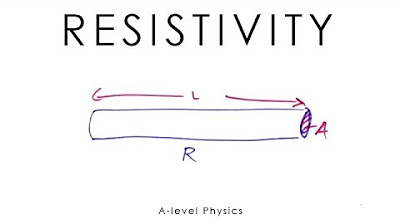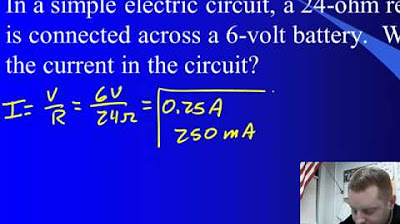Resistivity and conductivity | Circuits | Physics | Khan Academy
TLDRThe video script explains Ohm's law and the concept of resistance in electrical circuits. It describes how resistance is defined by the voltage across a resistor divided by the current through it, and is a constant for Ohmic materials. Factors affecting resistance include the material's resistivity, the length and cross-sectional area of the resistor. A mnemonic, 'Replay', is introduced to remember the formula R = ρ(L/A). The analogy of water flowing through a pipe is used to illustrate these concepts, and an example calculation estimates the resistance of a copper wire.
Takeaways
- 📋 Ohm's Law states that the voltage across a resistor equals the current through it times the resistance.
- 🔌 Resistance is defined as the voltage applied across a resistor divided by the current through it, with units in ohms.
- ⚠️ Increasing voltage does not increase resistance; it increases current while the resistance remains constant for Ohmic materials.
- 📏 The resistance of a resistor is directly proportional to its length and inversely proportional to its cross-sectional area.
- 🔄 The formula for resistance is R = ρ(L/A), where R is resistance, ρ is resistivity, L is length, and A is cross-sectional area.
- 📐 Resistivity (ρ) is a material property that quantifies how much a material naturally resists the flow of current, with units of ohm meters.
- 🔧 Materials like metals have low resistivity and are good conductors, while non-metals have high resistivity and are poor conductors.
- 🔄 Electrical conductivity (σ) is the inverse of resistivity, where σ = 1/ρ and ρ = 1/σ.
- 💡 The resistivity of copper is 1.68 × 10^-8 ohm meters, making it an excellent conductor.
- 🌊 Analogy: Resistance to current is like water flowing through a pipe, where resistivity is analogous to the pipe material and constriction to the cross-sectional area.
- 📊 Example calculation: A 12-meter copper wire with a diameter of 0.01 meters has a resistance of approximately 0.0026 ohms.
Q & A
What is Ohm's law and how is it used to calculate current in a circuit?
-Ohm's law states that the voltage (V) across a resistor (R) is equal to the current (I) flowing through it times the resistance of the resistor. It is used to calculate the current in a circuit by rearranging the formula to I = V/R, which means the current is the voltage divided by the resistance.
How is resistance defined and what are its units?
-Resistance is defined as the amount of voltage applied across a resistor divided by the amount of current flowing through it. The units of resistance are ohms (Ω).
What is the relationship between voltage, current, and resistance in an Ohmic material?
-In an Ohmic material, the resistance remains constant regardless of changes in voltage or current. The voltage and current are directly proportional, meaning if you increase the voltage, the current will also increase, maintaining the same resistance value.
How does the length of a resistor affect its resistance?
-The resistance of a resistor is directly proportional to its length. If the length of the resistor is doubled, the resistance will also double.
How does the cross-sectional area of a resistor influence its resistance?
-The resistance of a resistor is inversely proportional to its cross-sectional area. Increasing the area will decrease the resistance, as it provides more room for the current to flow through.
What is resistivity and how does it vary with different materials?
-Resistivity is a property of a material that quantifies how much it naturally resists the flow of electric current. Different materials have different resistivities; metals typically have low resistivities and are good conductors, while non-metals like rubber have high resistivities and are poor conductors or insulators.
What is the relationship between resistivity (ρ), length (L), and cross-sectional area (A) in a resistor?
-The resistance (R) of a resistor can be calculated using the formula R = ρ * (L / A), where ρ is the resistivity of the material, L is the length of the resistor, and A is its cross-sectional area.
How can the concept of resistivity be remembered using a mnemonic?
-A mnemonic to remember resistivity is the 'Replay' formula, where R (resistance) equals rho (ρ), L (length) over A (area). This helps students recall the formula more easily.
What is the relationship between resistivity and electrical conductivity?
-Resistivity and electrical conductivity are inversely proportional. The resistivity of a material is equal to 1 divided by its electrical conductivity (σ), and vice versa, σ equals 1 divided by ρ.
How can the concept of resistance be analogized using water flowing through a pipe?
-Resistance in a circuit can be analogized to water flowing through a pipe. The resistivity is like the material of the pipe (affecting smoothness of flow), the length is like the length of a constriction in the pipe (longer means more resistance), and the cross-sectional area is like the size of the constriction (smaller area means more resistance).
Given a 12-meter long copper wire with a diameter of 0.01 meters and a resistivity of 1.68 x 10^-8 ohm meters, what is the resistance of the wire?
-Using the formula R = ρ * (L / A) and calculating the cross-sectional area (A = π * (r^2) where r is the radius, or half the diameter), the resistance of the wire is approximately 0.0026 ohms.
Outlines
🔋 Understanding Ohm's Law and Resistance
This paragraph introduces the concept of Ohm's Law, which states that the voltage across a resistor is equal to the current through it times the resistance of the resistor. It explains how to calculate the resistance by using the voltage and current and emphasizes that resistance is a property of the resistor itself, independent of the voltage and current applied. The paragraph also discusses the relationship between voltage, current, and resistance, clarifying that increasing voltage leads to increased current, but the resistance remains constant for Ohmic materials. It further explores how the resistance can be altered by changing the resistor's physical properties, such as size, material, and shape.
📏 Factors Affecting Resistance
This paragraph delves into the factors that affect the resistance of a resistor, including its length, cross-sectional area, and material's resistivity. It explains that resistance is directly proportional to the length of the resistor and inversely proportional to its cross-sectional area. The concept of resistivity is introduced as a measure of a material's inherent resistance to the flow of current, with resistivity values varying widely across different materials. The paragraph also presents the formula for calculating resistance, which depends on resistivity, length, and area, and provides a mnemonic, 'Replay', to remember the formula. Additionally, it contrasts resistivity with electrical conductivity, highlighting their inverse relationship.
🧪 Practical Example: Calculating Resistance of a Copper Wire
The final paragraph applies the concepts discussed earlier to a practical scenario of calculating the resistance of a copper wire. Given the resistivity of copper, the length of the wire, and its diameter, the paragraph uses the resistance formula to compute the wire's resistance. It also touches on the significance of wire resistance in delicate experiments and the natural flow of electrons through a conductor like copper. The example illustrates how to use the formula in a real-world context and reinforces the understanding of resistance and its determinants.
Mindmap
Keywords
💡Ohm's Law
💡Resistance
💡Resistor
💡Voltage
💡Current
💡Resistivity
💡Conductivity
💡Cross-Sectional Area
💡Length
💡Mnemonic
💡Analogies
Highlights
Ohm's law states that voltage across a resistor equals the current through it times the resistance.
Resistance is defined as the voltage applied across a resistor divided by the current through it.
The units of resistance are ohms.
Resistor's resistance is a constant and does not change with voltage or current if the material, size, or dimensions remain the same.
Ohmic materials maintain a constant resistance regardless of voltage or current.
The resistance of a resistor depends on its length, cross-sectional area, and the material it's made of.
Resistance is directly proportional to the length of the resistor.
Resistance is inversely proportional to the cross-sectional area of the resistor.
Resistivity (represented by the Greek letter rho) quantifies a material's natural resistance.
Resistivity has units of ohm meters.
The resistivity of copper is 1.68 times 10 to the negative eighth ohm meters.
Resistivity is inversely proportional to electrical conductivity.
The formula for resistance is R equals resistivity times length divided by area (R = ρ * L / A).
The mnemonic 'Replay' can help remember the resistance formula: R equals rho, L over A.
An analogy of water flowing through a pipe helps to understand how factors like length and area affect resistance.
The resistivity can be thought of as the 'roughness' of the material for the flow of electrons.
An example calculation shows that 12 meters of copper wire with a 0.01-meter diameter has a resistance of 0.0026 ohms.
Transcripts
5.0 / 5 (0 votes)
Thanks for rating:





